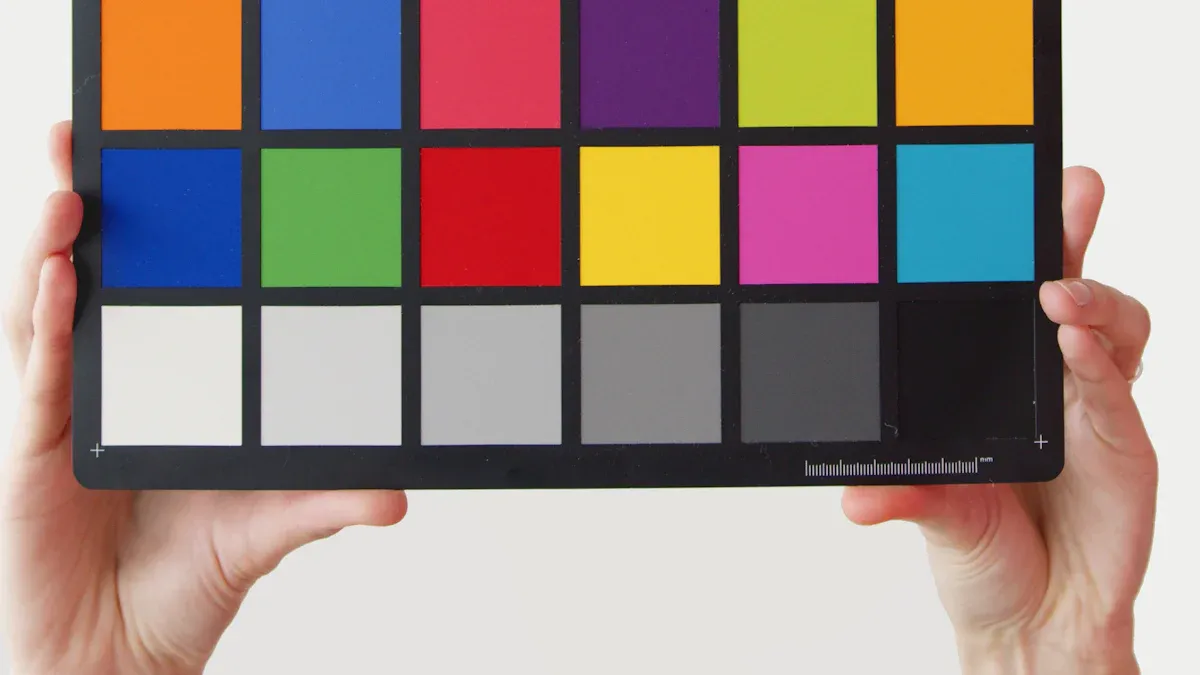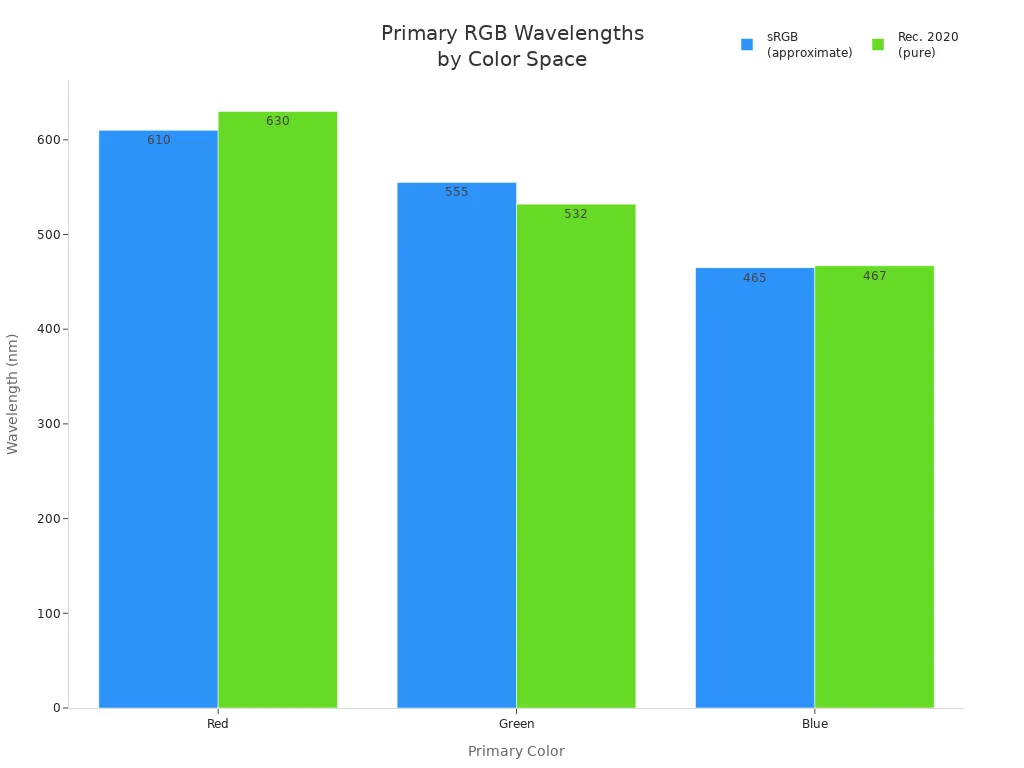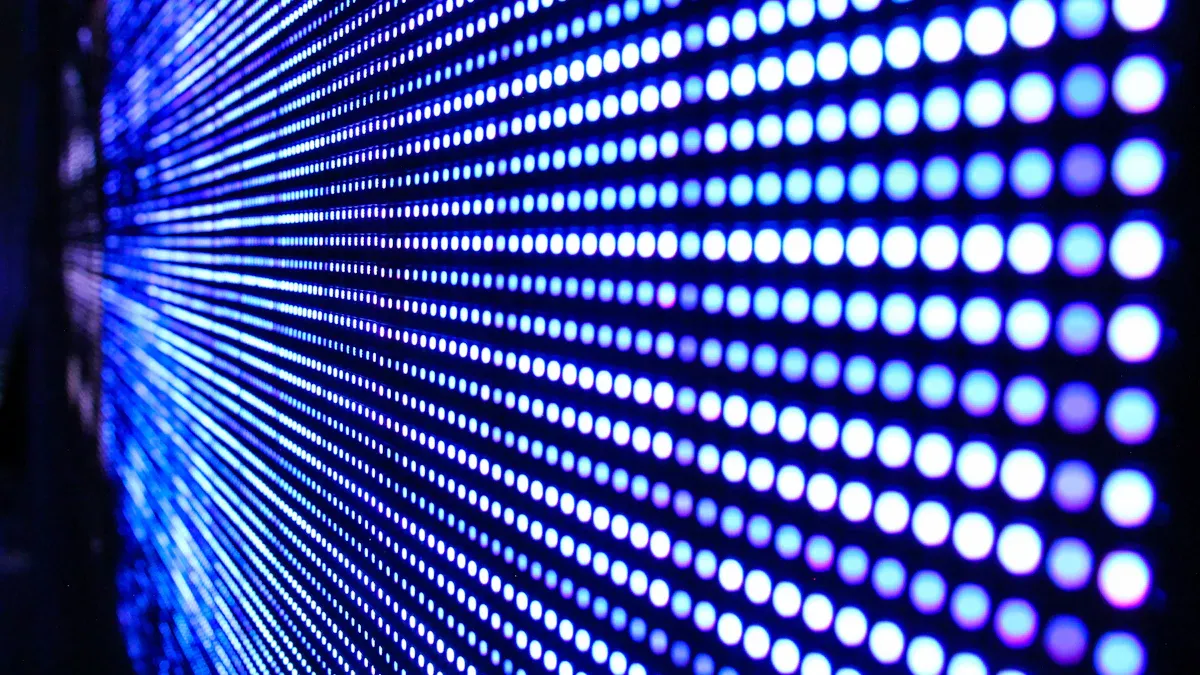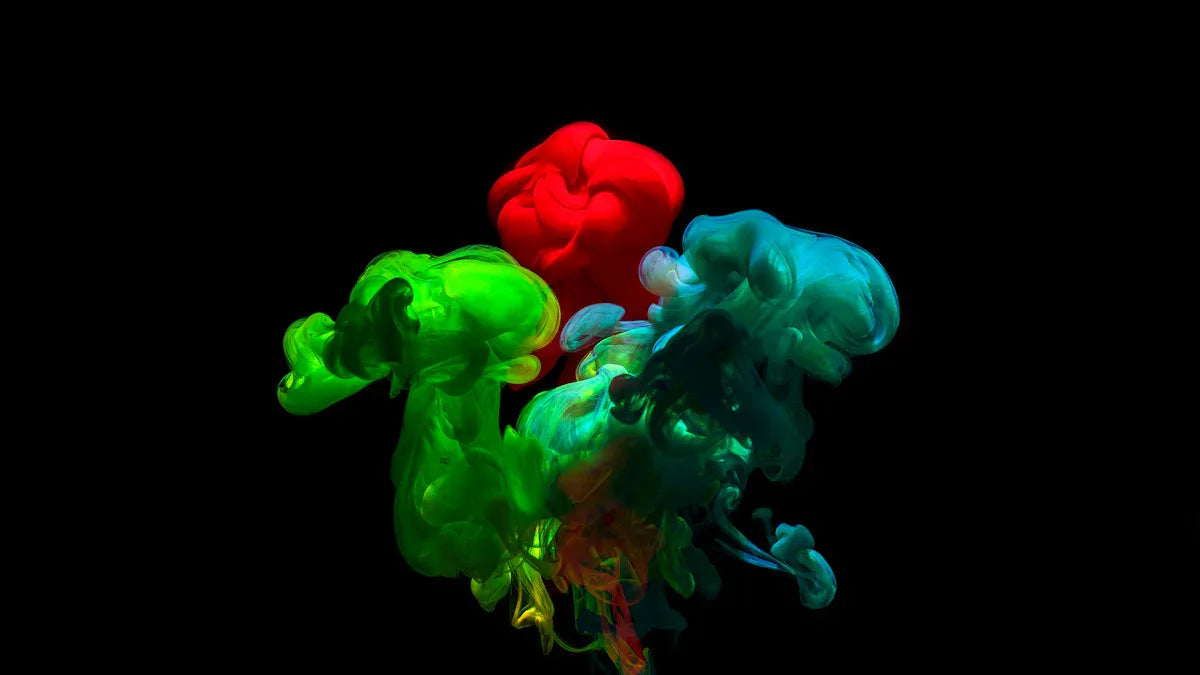RGB color mixing technology uses an additive model where red, green, and blue light combine at varying intensities of colored light. This color mixing process relies on the trichromatic nature of human vision, where three types of cones respond to different wavelengths. When all three colors reach full strength, the result is white light; absence of all produces black. The RGB color model forms the core of digital display systems, with each pixel on a display containing red, green, and blue LED elements. By adjusting the intensity of each LED, a display can reproduce a wide range of colors essential for digital imaging and lighting solutions.
Key Takeaways
- RGB stands for red, green, and blue, the primary colors of light used in digital screens and lighting.
- RGB color mixing uses an additive model, combining light intensities to create millions of colors, including white and black.
- Digital devices control RGB colors with values from 0 to 255 for each color, allowing precise color and brightness adjustments.
- The RGB color cube helps visualize how different red, green, and blue levels mix to form unique colors.
- RGB technology powers most digital displays like TVs, monitors, and smartphones by adjusting tiny red, green, and blue LEDs.
- Additive color mixing with RGB LEDs creates vibrant colors and is essential for modern lighting and display systems.
- RGB colors look bright and vivid on screens but do not work well for printing, which uses the subtractive CMYK model.
- Understanding RGB helps designers create consistent, lifelike colors across digital devices and improves digital design quality.
RGB Color Basics

What Is RGB
RGB stands for red, green, and blue, which are the three primary colors of light used in digital imaging and display technology. The rgb color model forms the foundation for most electronic screens, including televisions, monitors, and smartphones. Scientists in the late 19th century established that human color perception relies on these three colors. The rgb color model works by combining different intensities of red, green, and blue light to produce a wide range of visible colors. Isaac Newton’s early experiments with light mixing laid the groundwork for this model, showing that combining colored lights can create white light. The rgb color system is essential for devices that emit light directly to the viewer.
Primary Colors of Light
Red, green, and blue serve as the primary colors in the rgb color model. Each color corresponds to a specific range of wavelengths in the visible spectrum. The exact wavelengths can vary depending on the color space used. For example, the sRGB color space uses approximate wavelengths of 610 nm for red, 555 nm for green, and 465 nm for blue. In contrast, the Rec. 2020 standard uses pure spectral wavelengths.
|
Color Space |
Red (nm) |
Green (nm) |
Blue (nm) |
|---|---|---|---|
|
sRGB (approximate) |
~610 |
~555 |
~465 |
|
Rec. 2020 (pure wavelengths) |
630 |
532 |
467 |

Mixing these primary colors in different combinations creates secondary colors. For instance, red and green make yellow, green and blue make cyan, and red and blue make magenta. When all three primaries combine at full intensity, the result is white light. The absence of all three produces black.
Note: The rgb color model is the basis for most color displays and electronic devices using RGB LEDs.
Additive Model
The rgb color model uses the additive color model, which creates color by adding light. This process starts with black, representing no light. As red, green, and blue light beams combine at varying intensities, new colors emerge. When all three colors reach maximum intensity, the result is white. Digital screens use this principle by emitting rgb light from each pixel to simulate a full spectrum of colors.
- The additive color model sums the brightness of each component.
- Intermediate intensities produce a wide range of colors, including secondary colors.
- The perceived color depends on the intensity of each rgb component.
The additive color model differs from subtractive models, which use pigments or inks to absorb light. Additive mixing results in brighter, more vibrant colors and covers a broader spectrum. This approach is essential for devices that emit light, such as monitors and LED displays.
RGB Color Mixing Science
Additive vs Subtractive
Additive color mixing describes how light sources combine to create new colors. The rgb color model uses this principle. In the additive color system, red, green, and blue lights blend together. When all three lights shine at full intensity, the result is white. If none of the lights are present, the result is black. This process works because each colored light adds its wavelength to the mix, so the eye receives more light as colors combine.
Subtractive color mixing works differently. It involves pigments or inks, not light. Pigments absorb certain wavelengths and reflect others. When mixing cyan, magenta, and yellow pigments, each pigment removes some wavelengths from white light. The color seen is the result of the remaining reflected light. Subtractive mixing produces darker and duller colors because each pigment absorbs more light. Printers and paints use this method, not the rgb color model.
The main difference: additive color mixing adds light, while subtractive mixing removes light through absorption.
Intensity Scale (0-255)
Digital devices use numbers to control the brightness of each rgb channel. Each channel—red, green, and blue—has an intensity value from 0 to 255. Zero means no light for that color, and 255 means the brightest possible light. This scale allows for 256 levels per channel. By combining these levels, digital systems can create over 16 million colors.
For example:
- (255, 0, 0) shows pure red.
- (0, 255, 0) shows pure green.
- (0, 0, 255) shows pure blue.
- (255, 255, 0) creates yellow by mixing red and green.
- (255, 255, 255) produces white when all channels are at maximum.
- (0, 0, 0) results in black when all channels are at zero.
This 0-255 scale is a digital abstraction. Devices store these values as 8-bit numbers. The actual brightness depends on the device and color space, such as sRGB or Adobe RGB. The scale helps standardize color representation across screens and images.
Tip: The 0-255 scale is not a direct measure of physical light but a way for computers to manage and display colors.
RGB Color Cube
The rgb color cube is a three-dimensional model that helps visualize how colors mix in the rgb color model. Each axis of the cube represents one primary color: red, green, or blue. The value along each axis ranges from 0 to 1 in mathematical models, or from 0 to 255 in digital systems. Every point inside the cube stands for a unique color created by mixing different intensities of the three primaries.
- The origin (0, 0, 0) is black.
- The opposite corner (1, 1, 1) or (255, 255, 255) is white.
- The edges and faces show pure and mixed colors, such as cyan, magenta, and yellow.
Mathematically, the rgb color space forms a vector space. Each color is a combination of the three basis vectors—red, green, and blue. The cube's structure allows for easy calculation and visualization of color mixing. In digital graphics, the rgb color cube contains 16,777,216 distinct colors, since each channel has 256 possible values.
Note: The rgb color cube is fundamental for understanding how digital screens and graphics software create and display colors.
Color Creation
Mixing Red, Green, Blue
Mixing red, green, and blue light forms the basis of the rgb color model. This process, called additive color mixing, combines different intensities of these three colors to create a wide spectrum. Devices like computer monitors, televisions, and smartphones use this method. Each pixel on a digital screen contains tiny led elements for red, green, and blue. By adjusting the brightness of each led, the device can display millions of colors.
The most common method for creating new colors with rgb involves changing the intensity of each led. When red and green light mix, the result is yellow. Mixing green and blue produces cyan, while red and blue create magenta. As more colors are added, the mixture moves closer to white light. This principle allows led screens to show vibrant images and videos.
|
Primary Colors Mixed |
Resulting Color (Secondary) |
|---|---|
|
Red + Green |
Yellow |
|
Red + Blue |
Magenta |
|
Green + Blue |
Cyan |
Led lighting systems also use rgb mixing to produce custom colors for displays, signs, and decorative effects. Some advanced led setups use microcontrollers to control each rgb led individually, enabling dynamic color changes and patterns. The efficiency and flexibility of led technology make it ideal for rgb color mixing in both screens and lighting.
Note: Additive color mixing with rgb leds is the most efficient way to create a wide range of colors in modern digital devices.
Human Vision
Human vision detects colors produced by rgb mixing through specialized cells in the retina called cone cells. These cones come in three types, each sensitive to a different part of the visible spectrum: short wavelengths (blue), medium wavelengths (green), and long wavelengths (red). When light from an rgb led display enters the eye, it stimulates these cones in varying amounts. The brain then interprets the combined signals to perceive different colors.
The rgb color model matches the way cone cells respond to light, making it effective for digital screens and led lighting. However, color perception involves more than just mixing rgb values. The eye processes color along opponent axes, such as blue/yellow and green/magenta. This means that some color combinations, like blue and yellow, cannot be seen together at the same spot. Instead, the brain alternates between the two, creating unique visual effects.
For accurate color mixing on digital devices, engineers often convert rgb values to a linear color space before blending them. This step ensures that doubling the value of an rgb led actually doubles the light output, which aligns better with how people perceive brightness and color. The combination of rgb led technology and the biology of human vision allows digital devices to reproduce a vast range of colors that appear natural to the eye.
RGB LED Displays & Applications

Digital Screens
RGB LED displays form the backbone of modern digital screens. Each display uses an array of tiny RGB LED modules to create images and videos. Every pixel in these screens contains three separate LEDs—one red, one green, and one blue. By adjusting the intensity of each LED, the display produces millions of colors. This technology appears in televisions, computer monitors, smartphones, and even large outdoor billboards.
Full color LED displays rely on this principle to deliver vibrant visuals. The RGB LED module design allows for high brightness and sharp contrast, making these screens suitable for both indoor and outdoor environments. Digital screens with RGB LED displays offer wide viewing angles and long lifespans. The modular structure of RGB LED displays also enables manufacturers to build screens of various sizes and shapes, from small handheld devices to massive stadium displays.
LED Lighting
LED lighting systems use RGB color mixing to create a wide range of colors for decorative and functional purposes. Each RGB LED module in these systems contains separate red, green, and blue emitters. The system calculates the chromaticity coordinates for each LED and the target color, often referencing the D65 white point on the CIE 1931 chromaticity diagram.
Unlike older CRT displays, LEDs have unique spectral properties. Engineers must recalculate mixing ratios for accurate color reproduction. They use algebraic methods, such as the center of gravity technique, to determine the correct intensity for each color. The system then adjusts the drive currents for each LED based on these ratios and the luminous intensity of each emitter. This process ensures precise color rendering and consistent luminance.
RGB LED modules in lighting applications appear in architectural lighting, stage effects, and smart home systems. These modules allow users to select from millions of colors, set dynamic scenes, and even synchronize lighting with music or video content.
Note: RGB LED displays and modules provide unmatched flexibility in both display and lighting applications.
Advanced RGB LED Control
Advanced RGB LED control enables dynamic lighting effects and interactive displays. Microcontrollers manage each RGB LED module, allowing for precise adjustments in color, brightness, and timing. This level of control supports animations, gradients, and synchronized effects across large RGB LED displays.
However, several technical challenges exist in advanced RGB LED control:
- Electrical issues, such as faulty wiring or voltage drops, can cause flickering or inconsistent brightness.
- Connectivity problems may result from loose connections or controller failures, especially in smart systems.
- Maintaining uniform color and brightness across all RGB LED modules proves difficult due to power inconsistencies and LED degradation.
- Environmental factors, including heat and moisture, can damage LEDs or cause adhesive failure.
- Advanced controllers require regular software updates and compatibility checks.
- Installation challenges include ensuring proper heat dissipation, secure mounting, and waterproofing.
- Physical damage, such as bending or crushing, can cause sections of the display to fail.
- Adhesive failure may require additional mounting solutions.
- Proper planning for layout, power supply, and mounting helps prevent voltage drops and mechanical stress.
RGB LED displays and modules continue to evolve, offering new possibilities in digital signage, entertainment, and architectural design. The combination of precise color control and flexible installation makes RGB LED technology a key component in modern visual and lighting systems.
RGB in Digital Design
Color Palettes
Designers use the rgb color scheme to build color palettes for digital design. This approach allows them to select precise colors for websites, apps, and graphics. The rgb color scheme gives access to over 16 million possible colors by adjusting the intensity of red, green, and blue. Designers often choose a set of base colors and then create variations by changing the rgb values. This method helps maintain consistency across different screens and devices.
A typical rgb color scheme for a user interface might include:
|
Color Name |
RGB Value |
Use Case |
|---|---|---|
|
Primary |
(34, 139, 230) |
Buttons, links |
|
Accent |
(255, 99, 71) |
Highlights |
|
Neutral |
(240, 240, 240) |
Backgrounds |
|
Warning |
(255, 215, 0) |
Alerts |
Designers rely on led screens to display these palettes accurately. Each led emits red, green, or blue light at specific intensities, matching the selected rgb color scheme. This process ensures that the intended colors appear the same on different devices. The rgb color scheme also supports accessibility by allowing designers to adjust contrast and brightness for better visibility.
Tip: Using a consistent rgb color scheme improves brand recognition and user experience in digital design.
Rendering & Gradients
Gradients add depth and dimension to digital design. Designers create gradients by blending two or more colors from the rgb color scheme. Each led in a display adjusts its output to produce smooth transitions between colors. The process involves calculating intermediate rgb values for each step in the gradient.
Several techniques influence how gradients appear on led screens:
- Rendering intents determine how colors convert and display across devices.
- Perceptual intent compresses the color space evenly, keeping gradients smooth and uniform. Designers often use this for rgb to cmyk conversions.
- Relative Colorimetric intent maps colors precisely but can cause banding in gradients, especially at the edges of the rgb color scheme.
- Absolute Colorimetric intent simulates paper white, which helps in print previews but may not suit all digital design needs.
- Saturation intent focuses on vividness, using the full output of each led, but may sacrifice accuracy in gradients.
Designers must consider these rendering intents when working with gradients. The choice affects how the rgb color scheme appears on different led displays. Perceptual intent often provides the best results for smooth tonal transitions, while other intents may introduce visible steps or color shifts.
Note: Proper gradient rendering ensures that digital design projects look professional and visually appealing on any led device.
RGB vs Other Models
RGB vs CMYK
The RGB and CMYK color models serve different purposes in the world of color technology. RGB stands for red, green, and blue. It uses an additive process, where combining these three colors of light at varying intensities creates a broad spectrum of colors. This model can produce up to 16.7 million distinct colors, making it ideal for digital displays such as monitors, smartphones, and televisions. The colors appear vibrant and bright because the model adds light to create new shades.
CMYK, on the other hand, stands for cyan, magenta, yellow, and black. It uses a subtractive process, where inks absorb light rather than emit it. This model is standard for printed materials like books, posters, and business cards. CMYK can produce about 16,000 colors, which is far fewer than RGB. The subtractive method means that mixing all inks results in a darker color, with black added to achieve deeper tones.
|
Model |
Color Process |
Components |
Color Range |
Main Use |
|---|---|---|---|---|
|
RGB |
Additive |
Red, Green, Blue |
~16.7 million |
Digital screens |
|
CMYK |
Subtractive |
Cyan, Magenta, Yellow, Black |
~16,000 |
Printed materials |
Designers often notice that colors created in RGB appear less vibrant when converted to CMYK for printing. This happens because CMYK cannot reproduce the full range of colors visible on digital screens. For this reason, digital projects use RGB, while print projects require CMYK. Converting between these models can cause color shifts, so it is important to choose the right model based on the final output.
Other Models
Besides RGB and CMYK, several other color models help designers and engineers work with color more intuitively. The HSL (Hue, Saturation, Lightness) model breaks color into three components: hue (the type of color), saturation (the intensity), and lightness (the brightness). HSL uses a circular scale for hue, ranging from 0° to 360°, and percentages for saturation and lightness. This structure makes it easier for people to select and adjust colors based on how they perceive them.
The HSV (Hue, Saturation, Value) model is similar to HSL but uses value instead of lightness. Both HSL and HSV allow users to create color palettes and variations more naturally than RGB, which relies on adjusting three separate light intensities. However, these models do not always provide consistent results when changing saturation or brightness.
The LAB color model takes a different approach. It aims to represent all colors visible to the human eye, not just those produced by mixing lights or inks. LAB separates color into three values: L for lightness, a for the green–red axis, and b for the blue–yellow axis. This model offers better color consistency and is useful for tasks that require precise color matching.
- RGB: Best for digital displays, uses light intensity.
- HSL/HSV: More intuitive for humans, uses hue, saturation, and lightness/value.
- LAB: Captures the full range of human vision, ensures color consistency.
While RGB remains the standard for digital devices, models like HSL and LAB provide tools for more accurate and user-friendly color selection. Each model has strengths and limitations, so choosing the right one depends on the specific needs of a project.
Pros and Cons
Advantages
RGB color mixing technology offers several important benefits in digital applications. This model allows users to create a wide range of colors by adjusting the intensity of red, green, and blue channels. Designers can build harmonious and organic color relationships by changing the ratios of these channels. This systematic approach resembles using a grid in layout design, making color palette creation more organized and predictable.
- Wide Color Gamut: RGB mixing covers a broad spectrum of colors, resulting in lifelike visuals on screens. This capability is essential for digital design, photography, gaming, and video production.
- Additive Brightness Control: The additive nature of RGB means that increasing the intensity of each channel makes the image brighter. This feature gives precise control over both color and brightness.
- Fine Adjustment: The 8-bit per channel system provides 256 levels for each color, allowing for subtle changes and smooth gradients. This granularity helps designers achieve the exact shade they want.
- Consistency Across Devices: RGB technology delivers consistent color reproduction on different screens, which is important for professionals who need reliable results.
- Simplicity in Digital Design: Working directly in the RGB color space simplifies the process of creating and editing colors. Designers can use hexadecimal codes to specify colors, making the system convenient and widely applicable.
- Avoids Arbitrary Effects: RGB mixing does not introduce unexpected changes in hue or brightness, unlike some other models such as HSB.
RGB color mixing forms the foundation of most digital displays, making it a practical and efficient choice for modern technology.
Limitations
Despite its strengths, RGB color mixing has several limitations that affect its use in certain situations. The model relies on light emission, which makes it ideal for screens but unsuitable for print media. Printing uses the CMYK color model, which works by absorbing light rather than emitting it. As a result, colors created in RGB often look different or dull when printed, because the RGB color gamut includes shades that CMYK cannot reproduce.
- Not Suitable for Printing: RGB colors cannot be directly used in print. Designers must convert RGB artwork to CMYK, which can cause color shifts and require manual correction.
- Hardware Constraints: Digital displays use fixed wavelengths for red, green, and blue emitters. These physical limits prevent screens from showing every possible color, especially certain blues and purples.
- Inconsistent Appearance: Colors may appear differently on various screens due to differences in calibration, display technology, and environmental factors. This inconsistency can make it difficult to achieve perfect color matching across devices.
- Limited by Display Technology: The accuracy of RGB color reproduction depends on the quality of the screen. Some colors may not be rendered precisely because of hardware limitations and the discrete intensity levels available.
- Additive Model Restrictions: The additive process increases brightness but cannot replicate the way inks blend in print. This difference means that RGB is not practical for packaging or other physical media.
Designers working on projects for both digital and print must understand these limitations to ensure accurate and consistent color results.
RGB color mixing technology forms the foundation of every digital display and led system. Each display uses red, green, and blue led elements to create millions of colors. This approach allows digital screens, led lighting, and modern display devices to produce vibrant visuals. Professionals in digital design rely on RGB to ensure their work appears vivid and consistent across every display and led-equipped device. Everyday users benefit from understanding how each led and display pixel works together to create lifelike images. The evolution of display technology and led advancements continues to depend on RGB color mixing, making it essential knowledge for anyone interacting with digital media.
Mastering RGB color mixing helps users and professionals achieve accurate color results on any display or led platform.
- RGB enables lifelike visuals on every display and led device.
- Understanding RGB supports better results in digital design, photography, and led-based applications.
FAQ
What does RGB stand for in color mixing technology?
RGB stands for Red, Green, and Blue. These three colors form the basis of the additive color model used in digital displays and lighting. Devices mix these colors at different intensities to create a wide range of visible colors.
What makes RGB color mixing different from CMYK?
RGB uses light to create colors through addition. CMYK uses ink or pigment to create colors through subtraction. RGB works best for screens and digital devices. CMYK is standard for printing on paper and other physical materials.
What devices use RGB color mixing?
Most digital screens use RGB color mixing. This includes televisions, computer monitors, smartphones, tablets, and LED displays. RGB technology also appears in LED lighting systems and digital signage.
What is the RGB color cube?
The RGB color cube is a three-dimensional model. Each axis represents one primary color: red, green, or blue. Every point inside the cube shows a unique color created by mixing different intensities of these three colors.
What happens when all RGB values are set to zero?
When all RGB values are set to zero, the result is black. The screen emits no light from any of the red, green, or blue channels. This setting creates the darkest possible color on a digital display.
What is the maximum number of colors RGB can produce?
RGB color mixing can produce over 16 million colors. Each channel—red, green, and blue—has 256 intensity levels. The combination of these levels creates 256 × 256 × 256 possible color variations.
What are common problems with RGB LED displays?
Common problems include color inconsistency, flickering, and brightness loss. These issues often result from faulty wiring, power supply problems, or LED aging. Proper installation and regular maintenance help prevent most of these problems.
What is additive color mixing?
Additive color mixing combines different colored lights to create new colors. Red, green, and blue lights mix together in varying amounts. When combined at full intensity, they produce white light. This process forms the basis of RGB technology.

